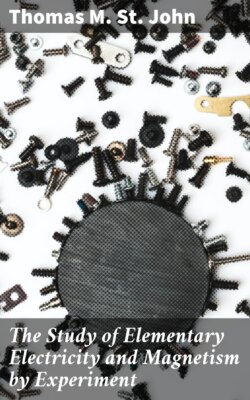Читать книгу The Study of Elementary Electricity and Magnetism by Experiment - Thomas M. St. John - Страница 4
На сайте Литреса книга снята с продажи.
CHAPTER I.
IRON AND STEEL.
ОглавлениеTable of Contents
1. Introduction. We should know something about iron and steel at the start, because we are to use them in nearly every experiment. The success with some of the experiments will depend largely upon the quality of the iron and steel used.
When we buy a piece of iron from the blacksmith, we get more than iron for our money. Hidden in this iron are other substances (carbon, phosphorus, silicon, etc.), which are called "impurities" by the chemist. If all the impurities were taken out of the iron, however, we should have nothing but a powder left; this the chemist would call "chemically pure iron," but it would be of no value whatever to the blacksmith or mechanic. The impurities in iron and steel are just what are needed to hold the particles of iron together, and to make them valuable. By regulating the amount of carbon, phosphorus, etc., manufacturers can make different grades and qualities of iron or steel.
When carbon is united with the pure iron, we get what is commonly called iron.
2. Kinds of Iron and Steel. Cast iron is the most impure form of iron. Stoves, large kettles, flatirons, etc., are made of cast iron. Wrought iron is the purest form of commercial iron. It usually comes in bars or rods. Blacksmiths hammer these into shapes to use on wagons, machinery, etc. Steel contains more carbon than wrought iron, and less than cast iron.
Soft steel is very much like wrought iron in appearance, and it is used like wrought iron.
Hard steel has more carbon in it than soft steel. Tools, needles, etc., are made of this.
EXPERIMENT 1. To study steel.
Apparatus. A steel sewing-needle (No. 1). [A]
[A] NOTE. Each piece of apparatus used in the following experiments has a number. See "Apparatus list" at the back of this book for details. The numbers given under "Apparatus," in each experiment, refer to this list.
3. Directions. (A) Bend a sewing-needle until it breaks. Is the steel brittle?
(B) If you have a file, test the hardness of the needle.
4. Discussion. "Needle steel" is usually of good quality. It will be very useful in many experiments. Do you know how to make the needle softer?
EXPERIMENT 2. To find whether a piece of hard steel can be made softer.
Fig. 1.
Apparatus. Fig. 1. A needle; a cork, Ck (No. 2); lighted candle (No. 3). The bottom of the candle should be warmed and stuck to a pasteboard base.
5. Directions. (A) Stick the point of the needle into Ck, Fig. 1, then hold the needle in the flame until it is red-hot. (The upper part of the flame is the hottest.)
(B) Allow the needle to cool in the air.
(C) Test the brittleness of the steel by bending it. Test its hardness with a file (Exp. 1).
6. Annealing. This process of softening steel by first heating it and then allowing it to cool slowly, is called annealing. All pieces of iron and steel are, of course, hard; but you have learned that some pieces are much harder than others.
EXPERIMENT 3. To find whether a piece of annealed steel can be hardened.
Apparatus. The needle just annealed and bent; cork, etc., of Exp. 2; a glass of cold water.
7. Directions. (A) Heat the bent portion of the needle in the candle flame (Exp. 2) until it is red-hot, then immediately plunge the needle into the water.
(B) Test its brittleness and hardness, as in Exp. 2.
8. Hardening; Tempering. Good steel is a very valuable material; the same piece may be made hard or soft at will. By sudden cooling, the steel becomes very hard. This process is called hardening, but it makes the steel too brittle for many purposes. By tempering is meant the "letting down" of the steel from the very hard state to any desired degree of hardness. This may be done by suddenly cooling the steel when at the right temperature, it not being hot enough to produce extreme hardness. (The approximate temperature of hot steel can be told by the colors which form on a clean surface. These are due to oxides which form as the steel gradually rises in temperature.)
EXPERIMENT 4. To test the hardening properties of soft iron.
Apparatus. A piece of soft iron wire about 3 in. (7.5 cm.) long (No. 4); the candle, water, etc., of Exp. 3.
9. Directions. (A) Test the wire by bending and filing.
(B) Heat the wire in the candle flame as you did the needle (Fig. 1), then cool it suddenly with the water. Study the results.
10. Discussion. Soft iron contains much less carbon than steel. The hardening quality which steel has is due to the proper amount of carbon in it. If you have performed the experiments so far, you will be much more able to understand later ones, and you will see why we are obliged to use soft iron for some parts of electrical apparatus, and hard steel for other parts.
